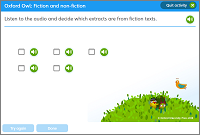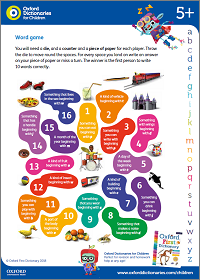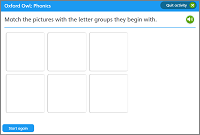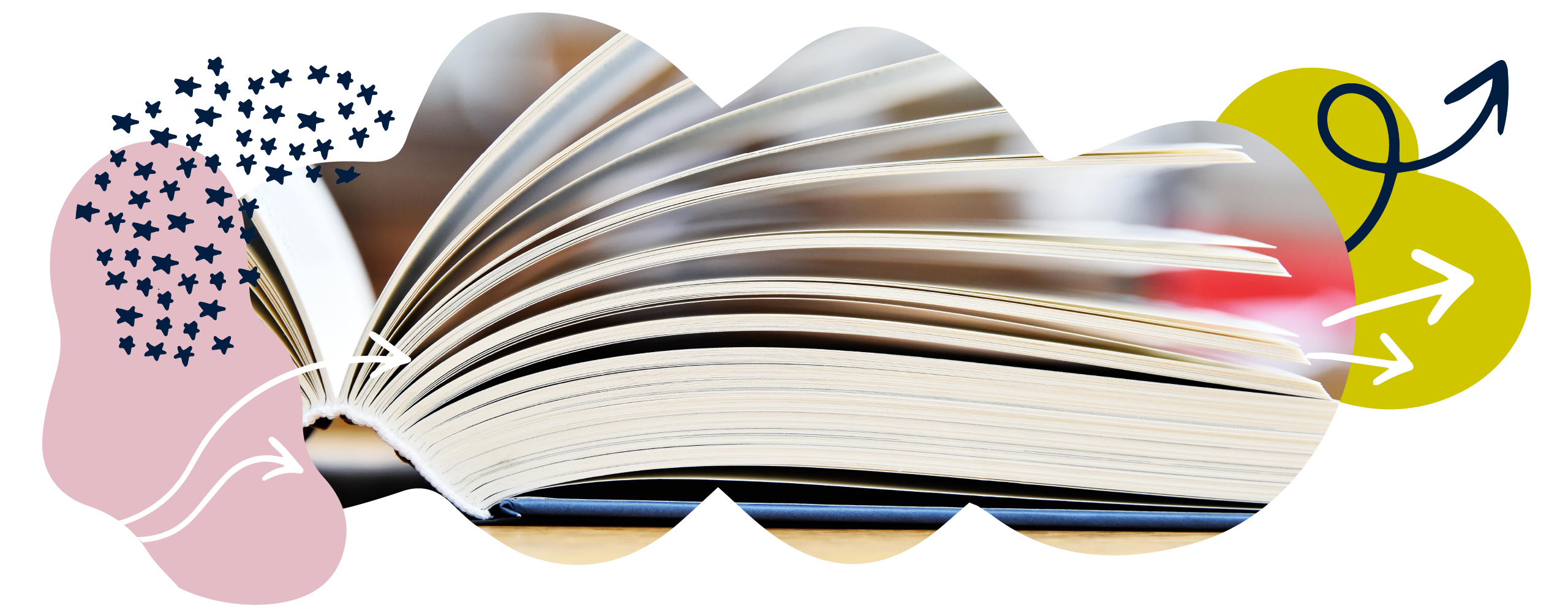Grammar and literacy glossary: J to Q
Need a refresher on fronted adverbials or the passive voice? Get to know what your child is learning at school with our guide to common terms and phrases used in schools.
For help with general educational terms, take a look at the Education glossary.
For help with maths terms, take a look at the Maths glossary.
A | B | C | D | E | F | G | H | I | J | K | L | M | N | O | P | Q | R | S | T | U | V | W | X | Y | Z
Levelled books
Books from a reading series that have been written in levels of difficulty to enable a child to take small but steady steps to reading success.
As children’s skills increase, so children can read more and the need for such careful levelling lessens. Read more about book bands and reading levels.
Modal verb
A type of auxiliary verb.
Modal verbs are: ‘can’, ‘could’, ‘will’, ‘would’, ‘may’, ‘might’, ‘shall’, ‘should’, ‘must’, and ‘ought to’.
Modal verbs are used for expressing:
- Possibility, ability or likelihood: ‘can’, ‘could’, ‘may’, ‘might’, ‘should’.
- Necessity: ‘must’, ‘ought to’, ‘should’.
- The future: ‘shall’, ‘will’, ‘would’.
Activity: Modal verbs

Make the word cube and use it to complete the sentences.
Morphology
A morpheme is a unit of meaning that cannot be divided further. Morphemes are the bits that make up words, such as read and ing in ‘reading’ or read and s in ‘reads’. A word consists of one or more morphemes.
Some morphemes are words in their own right; others, such as many prefixes and suffixes, are not.
Mnemonics
Memory joggers such as a rhyme, a phrase or a shape. For example, seeing a dinosaur in the shape of a letter ‘d’ might help your child to associate the dinosaur with the letter ‘d’ and the ‘d’ sound.
Video: What are mnemonics?
Learn how mnemonics help us spell difficult words like ‘please’ and ‘friend’.
Activity: Fiction and non-fiction

Listen to the audio and decide which extracts are from fiction texts.
Noun
A noun names a person, place or thing.
Apple, dog, team, chair, happiness, beauty.
Test whether something is a noun by seeing whether a determiner in front of it makes sense.
‘The apple’, ‘my dog’, ‘their team’, ‘her chair’ and ‘that beauty’ would all make sense in a sentence, but ‘the reads’, ‘those cuddly’, ‘her went’ would not.
Common noun: A noun that refers to people or things in general.
Dog, tree, bridge, chair, beauty, excitement, advice, bread.
Proper noun: A noun that identifies a particular person, place or thing. Proper nouns begin with capital letters.
James, Africa, Friday, December.
Noun phrase: A phrase with a noun as its head, or key word.
The ball was lost.
A noun phrase can be expanded by adding words before or after it.
The ball by the fence was lost. The red cricket ball by the fence was lost.
Activity: Word game

Guess the words from the descriptions.
Video: What are nouns?
Learn about common, concrete, and abstract nouns.
Paragraph
A group of linked sentences that are usually about the same thing. A new paragraph starts when you are writing about a new idea, person, place or event.
Parenthesis
Brackets, commas, and dashes can all be used to separate a word or phrase that has been added to a sentence as an explanation or afterthought. The word or phrase inside the brackets, commas or dashes is called a parenthesis.
I looked up, squinting because of the sun, and saw the birds flying across the sky.
Passive voice
In a passive sentence, the subject of the verb is the one that has something done to it, so the do-er disappears or is mentioned after ‘by’.
The ball was caught. The ball was caught by the little girl.
You can tell that a sentence is passive because:
- The subject of the verb has the action done to it.
- There is part of the verb ‘to be’ (such as ‘was’ or ‘is’) or a verb like ‘get’, followed by a past participle.
- The person or thing carrying out the action is introduced by the word ‘by’, or not at all.
Activity: Active and passive voice

Sort the sentences to show whether they are in the active or passive voice.
Video: What are active and passive sentences?
Learn the difference between active verbs and passive verbs.
Video: How to produce pure sounds
Learn how to pronounce all 44 phonics sounds, or phonemes, used in the English language.
Phonic books
See decodable books.
Phonics
A method of teaching children to read and write the English Language. It teaches children that the sounds of English are represented by letters or groups of letter. (Also see synthetic phonics).
Find out more about phonics on our Learn to read with phonics page.
Activity: Phonics

Match the pictures with the letter groups they begin with.
Video: What is phonics?
Get a definition of phonics and understand the key aspects of learning to read using phonics.
Video: What are phrases and clauses?
Learn how to use sentences, phrases, and clauses.
Picture books
Books in which the pictures play a major part in the story and the text is not levelled by difficulty (for example, The Gruffalo by Julia Donaldson). Picture books are not necessarily just for the very young and they can support the understanding of quite complex ideas (for example, Lost Thing by Shaun Tan).
Take a look at some of the latest picture books from Oxford University Press.
Plural
The plural of a noun is used when there is more than one. It is usually formed by adding -s.
‘Cat’ becomes ‘cats’; ‘cake’ becomes ‘cakes’.
Some nouns have irregular plural endings or no plural ending at all.
‘Bush becomes bushes’; ‘sheep stays as sheep’; ‘mouse becomes mice’.
Video: What are plurals?
Learn about plurals and the spelling rules for plural nouns.
Video: What are prefixes and suffixes?
Learn how to use prefixes and suffixes.
Preposition
A preposition usually comes before a noun or pronoun. It often shows place or direction.
A cat crept up the tree. Suddenly, the cat tried to pounce on the little green bird, but crashed into the tree.
Some prepositions show time or cause.
After this, the cat was furious with the bird.
More prepositions: ‘above’, ‘against’, ‘behind’, ‘below’, ‘beside’, ‘between’, ‘in’, ‘inside’, ‘near’, ‘on’, ‘off’, ‘onto’, ‘outside’, ‘over’, ‘through’, ‘under’.
Progressive
The progressive (or ‘continuous’) form is created by the verb ‘to be’ followed by the present participle of the verb. It describes an ongoing event.
The bird is pecking at the apples. The cat was looking at the bird.
The past progressive, formed with the past tense of the verb ‘to be’, can show that something was in the process of happening when something else happened.
I was going to the shops when I lost my glove.
Pronoun
A pronoun can be used instead of a noun. Using a pronoun avoids repeating the noun again and again.
The bird pecked the apple and ate it as he sat on a branch
Personal pronoun: Personal pronouns replace the name of a person or thing. The subject personal pronouns are ‘I’, ‘you’, ‘he’/’she’/’it’, ‘we’ and ‘they’. The object personal pronouns are ‘me’, ‘you’, ‘him’/’her’/’it’, ‘us’ and ‘them’.
Possessive pronouns: Possessive pronouns tell you who something belongs to.
This apple is mine!
Relative pronouns: Relative pronouns introduce more information about the noun.
The bird that sat on the branch was eating an apple.
The words where and when are also sometimes used as relative pronouns.
This is the house where I grew up.
Video: What are pronouns?
Learn about pronouns.
Punctuation
Punctuation marks are used in sentences to make the meaning clear. Sentences can mean very different things if they don’t have punctuation.
Let’s eat Granny! Let’s eat, Granny!
Video: Sentence types
Help your child learn about sentence types through these grammar activities and fun grammar games.
Pure sounds
Pure sounds are phonemes, the smallest units of sound in a word represented by single letters or groups of letters. It is important when saying pure sounds not to add an ‘uh’ to the end of the letter.
For the letter ‘m’, you should say ‘mm’, not ‘muh’. (A slight ‘uh’ cannot be helped when saying ‘b’, ‘d’, ‘g’, ‘j’, ‘w’ and ‘y’.)
Video: How to pronounce pure sounds
Learn how to pronounce all 44 phonics sounds, or phonemes, used in the English language.
Question
A question is a sentence that is used to find out information.
You can tell that a sentence is a question because:
- It ends with a question mark.
- It asks something.
- If there is a modal verb, it usually comes before the subject.
- It might start with ‘how’, ‘when’, ‘what’, ‘why’ or ‘where’.
Video: Sentence types
Help your child learn about sentence types through these grammar activities and fun grammar games.
